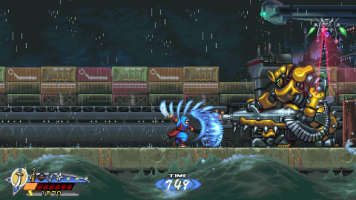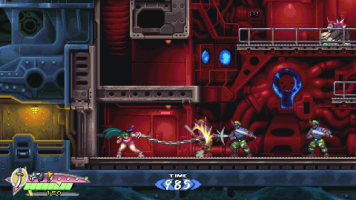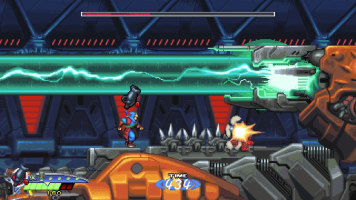Official Review
Not ones to let a good game be completely forgotten, the passionate developers at Tengo Project have brought this classic back for modern players as Shadow of the Ninja - Reborn. Sporting a gorgeous new art style and some additions and tweaks to the core gameplay, this reimagining of the 'other' NES ninja platformer offers up a fun and brutal return to basics.
The narrative in Shadow of the Ninja - Reborn is peak '90s cheese, placing you in control of two ninjas—Hayate and Kaede—who are sent to kill the dictator of a dystopian cyberpunk United States in 2029. As you'd probably expect, it plays in a similar vein to classic NES action platformers like Ninja Gaiden and Castlevania, tasking you with advancing through a linear series of stages packed with enemies, death pits, and bosses to master.
In their base kit, your ninja has access to a katana and a chain spear (also called a kusarigama) for attacking foes both near and far, and these can both be levelled up twice if you're fortunate enough to find a power-up orb. Rounding out your kit is a wealth of sub-weapons and items you can use to give you an edge in battle and cover combat situations that your base tools aren't as effective at tackling.
It's a simple and thrillingly action-packed gameplay loop, and it keeps its foot on the gas for the duration. You can hardly walk two steps without stumbling across another spike pit or having to dodge an enemy hurling something at your head, keeping you constantly on your toes lest you face an early death. Luckily, levels are usually broken up into three relatively short sub-levels, and if you happen to die (which you will) you're only made to start over from the beginning of your current sub-level. We especially appreciated this small mercy with bosses, as it can sometimes take a bit to learn the patterns even on the easiest difficulty mode, and you're not forced to run through the whole level again for another crack.
Naturally, those of you who aren't too quick on the thumbsticks may want to steer clear of Shadow of the Ninja - Reborn, because this is proudly a release from the 'Nintendo=Hard' era of games. Technically, you could beat Shadow of the Ninja Reborn in an hour or two if you're locked in and on top of your game, but these levels are designed to frustrate and punish you at nearly every turn. Not in a bad way—there's nothing here on the same level as the madness of the Castlevania Medusa heads—but it's almost assured that you'll spend a lot of your time nervously glancing at that dwindling health bar and trying to gauge how much longer you have till the next stage. There are some ways to heal, but they're quite scarce, so every mistake you make will stick with you as you struggle to press on.
Still, Shadow of the Ninja Reborn is the kind of game that can be beaten with simple persistence, and there are ways that you're helped along if you're really having a bad time. Typically, items and sub-weapons must be collected as you make your way through a stage, but there's a pity system in place where you'll be given increasingly more healing and booster items when you restart a stage after dying enough times. This feature ensures that even low-skill players can see the end if they stick it out enough and just keep trying. Even outside the pity items, we also really enjoyed how the sub-weapon system builds on the basic combat and gives you some new and helpful ways of dealing with enemies.
Once you beat a stage, all the new sub-weapons you collected there will then be unlocked for future runs, which helps to make repeat attempts a little different each time, if you wish. When you start a fresh save, you're presented with an item screen where you can 'buy' items for your starting inventory, with your wallet amount being calculated based on the score of your best run. More useful items obviously run you more points, but this is still a fun way to mix up the pace of a run and opens up challenge run opportunities with specific kits.
The original NES release was known for its enjoyable implementation of co-op and that's been replicated here in full form. Hayate and Kaede each have slightly different physics this time around, and having a friend on hand to assist in clearing out enemies goes a long way towards making the difficulty a little easier. You can't hurt each other or get in each other's way, and if one of you dies, the stage continues until your partner follows suit. It's perfect 'pick up and play' co-op action, and the brief length means that you and a friend can comfortably work together to beat the whole game in short order.
One of the most striking new additions for this remake is the visuals, which have received a huge facelift to a very generous interpretation of 16-bit spritework. As you roam through futuristic clocktowers, grimy sewers, and neon palaces, there's a tremendous sense of atmosphere that the 8-bit original obviously couldn't come even close to capturing. The colour palette is bright while Shunichi Taniguchi's spritework (especially for bosses) is impressively detailed. And if you want things to really have that retro tinge, there are some filters available to add effects like scanlines and give things a slightly more authentic old-school feel.
Much like the visuals, the soundtrack has received a similar upgrade, with the original composer, Iku Mizani, returning with new arrangements. The mixture of rock and chiptune feels like a great fit for the action onscreen, and though we didn't find many of the tracks to be particularly memorable, this soundtrack nonetheless accompanies the gameplay and visuals quite well.
Conclusion
Shadow of the Ninja - Reborn offers a tough and enjoyable return to this NES classic, expertly building upon what came before without erasing what made the original release great to begin with. Though it is a bit on the short side, there's enough replayability here to stretch out the experience for another few hours. We'd recommend this to anyone who's looking for a callback to the tough challenge of early Nintendo games—Shadow of the Ninja - Reborn has retro charm in spades and still stands tall even among modern 'neo-retro' platformers like Panzer Paladin and Gravity Circuit.





